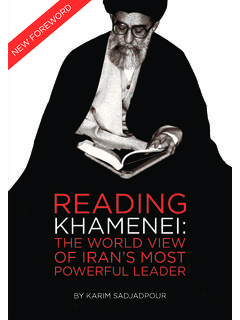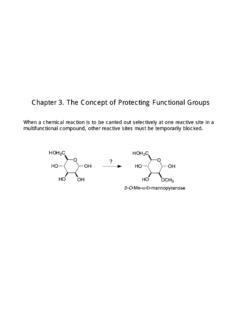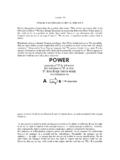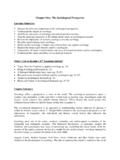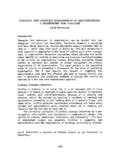Transcription of How to Upgrade U.S.-Japan Defense Cooperation
1 How to Upgrade Defense CooperationJAMES L. SCHOFFPOLICYOUTLOOK SUMMARYThe and Japanese governments have launched a yearlong initiative to rewrite their guidelines for bilateral Defense coopera-tion, a step undertaken only twice before in over a half-century. Current high levels of mutual suspicion and military competition in East Asia add drama to the effort and raise the stakes. If this initiative is not managed effectively, either an operationally or politically weaker alliance could emerge or regional misunderstanding could make conflict more and Japanese policymakers need an overarching concept for Defense guideline revision that allows the allies to improve their ability to respond to security challenges without exacerbating regional tensions or undermining domestic political support for the alliance in Japan. A front office/back office concept that keeps the overall division of labor intact but with deeper integration in certain support functions could thread this needle.
2 The Front Office/Back Office Concept Similar to the way a retail store leverages the entire company to maximize productivity at the point of sale, Japan s back office support functions could be better integrated with front office activities. Functions would be determined more by each force s capabilities than by geography or mission, which is the current method. Japanese capabilities in intelligence, surveillance, and reconnaissance (ISR), maritime force protection, or space situational awareness, for example, could be linked more directly to or multilateral forward operations when Japan s national security is involved. Keys to Deepening Front Office/Back Office Integration Incorporate functional working groups into scenario-based planning as part of the guideline revision process. Each scenario should include teams with expertise in certain areas such as ISR and cyberspace to identify functions that can be linked across different missions.
3 Include a working group focused on bilateral coordination to ensure that complex operational communication and political accountability issues are managed effectively. Emphasize interagency coordination throughout the process given the large number of involved parties. Reach out to other countries in Asia to maximize 20142 CARNEGIE ENDOWMENT FOR INTERNATIONAL PEACEJ ames L. Schoff is a senior associate in the Carnegie Asia Program. His research focuses on relations and regional engagement and Japanese politics and security. He previously served as senior adviser for East Asia policy at the Office of the Secretary of Defense and as director of Asia Pacific Studies at the Institute for Foreign Policy Analysis. His publications include a chapter on Japan in Strategy in the Second Nuclear Age: Power, Ambition, and the Ultimate Weapon (Georgetown University Press, 2012) and Tools for Trilateralism: Improving Cooperation to Manage Complex Contingencies (Potomac Books Inc.)
4 , 2005). ABOUT THE AUTHORHISTORIC OPPORTUNITY FOR THE ALLIANCEW ashington and Tokyo first developed bilateral Defense guidelines in 1978, against a backdrop of expanding Soviet naval power in East Asia and Japanese economic growth. By then Japan had improved its ability to contribute to shared security interests, and the United States wanted allies to assume greater responsibility for their own Defense . This resulted in Japan protecting sea lines of communication out to 1,000 nautical miles, while the concept of the United States as the alliance s offensive spear and Japan as defen-sive shield was decades later, North Korea s pursuit of nuclear weapons increased the potential for conflict on the Korean Peninsula. According-ly, the allies rewrote their Defense guidelines in 1997 to allow for more direct Japanese rear-area support to forces in situa-tions in areas surrounding Japan. But Japan interprets its constitution restrictively, which means that Japan s support cannot directly enable combat operations that are dis-connected from its own self- Defense .
5 Japan must also avoid operating where a battle might occur, and none of this rear-area sup-port is automatic because Japanese legislative approval is required. Thus, Japan s alliance contributions are strictly limited by mission (noncombat support) and by geography (rear-area operations). Another two decades later, the allies are poised to adjust again in response to North Korea s nuclear and missile advances, China s growing military capabilities, and the introduction of new domains cyberspace and outer space to the potential battlefield. For most of 2013, the United States and Japan reviewed their Defense guidelines in light of these new dynamics, and by October the two countries agreed that a new round of revision was warranted. The 2+2 joint statement issued by the secretaries of Defense and state and the Japanese minis-ters of foreign affairs and Defense instructed alliance managers to recommend changes to accomplish several objectives beyond the core mission of responding to a possible armed attack against Japan.
6 The aims include: 1. expanding the scope of bilateral Cooperation ,2. promoting security Cooperation with other regional partners,3. enhancing bilateral consultation and coordination mechanisms,4. describing the appropriate role sharing within bilateral Defense Cooperation , and5. evaluating bilateral Defense Cooperation in emerging strategic domains. The allies will pursue these objectives amid other evolving Japanese Defense reforms, stimulated by regional developments and quiet concern in Tokyo about staying power in the region. These reforms include establishing a new National Security Coun-cil to improve strategic decisionmaking and crisis management and possibly loosening restrictions on Japan s ability to participate in collective self- Defense , which could change how the allies cooperate in a North Korean crisis or a United Nations authorized peace enforcement operation. Washington and Tokyo must also navigate historical comparisons to past guideline revisions.
7 If the first two were largely about growing threats from the Soviet Union and North Korea, respectively, many assume HOW TO Upgrade Defense Cooperation 3mistakenly that this time it must be all about China. Any given security Cooperation mission involves an overlapping cycle of activity that runs continuously through information gathering, assessment and analysis, decision-making, planning, mobilization, execution, and back to information gathering, assess-ment, and so on. The goal of this revision effort should be to help Japan become a more meaningful and reliable partner in many of these activities, bilaterally with the United States as well as in broader coalitions. Exploring these opportunities concretely and then taking the steps necessary to opera-tionalize the most promising should be the primary objective of the Defense guideline revision process. This will be ambitious and complex given the need to bring together subject-matter experts from each country who have rarely worked together before but this is the task assigned by the 2+2.
8 CONCEPTUAL FRAMEWORK FOR GUIDELINE REVISIOND eveloping an overarching concept to guide this new era of alliance Cooperation will help the allies navigate the complex revision process. A conceptual framework similar to the spear/shield and forward area/rear area mantras of the past is necessary to describe for both internal and external audiences the purpose, value, and limits of alliance coopera-tion. It should serve as a bridge between the two nations Defense planning documents, and it will shape how each military perceives its role and manages the procurement and training associated with their Cooperation . Without a clear concept, alliance ties can weaken, Defense planning can lose focus, and neighbors are more likely to misinterpret alli-ance this framework begins with the underlying goal of the 2+2 joint statement that the United States and Japan should be full partners in a more balanced and effective Alliance in which they can jointly and ably rise to meet the regional and global chal-lenges of the 21st century.
9 Connectivity and interoperability are key enablers for any such jointness, and they are also highlighted in Japan s new National Security Strategy and National Defense Program Guidelines released in December 2013. The challenge is both to improve alliance capabilities and encourage broader security Cooperation with other nations to enhance regional stability, while discouraging military rivalry. To accomplish this, the alliance should pursue a capabilities-based (or functional) approach to Cooperation that can apply to different situations. A functional approach can enhance alliance flexibility and better integrate alliance Cooperation than the cur-rent approach without carving out new potentially politically sensitive overseas missions for Japan s Self- Defense Forces (SDF). This approach can be applied to the core alliance mission (responding to armed attack against Japan), as well as to wider regional/global security Cooperation scenari-os in both bilateral and multilateral contexts.
10 The new approach stands in contrast to the location- and mission-oriented nature of past and current guidelines. The current Defense guidelines from the 1990s make a distinction between forward-area and rear-area activities, and they identify specific missions that Japan s SDF can carry out on its own. This means that Washington and Tokyo do not fully leverage alliance potential because an I ll do this here, while you do that there dynamic leads to inefficiencies when resources are not shared. Japanese ISR to support its own minesweeping 4 CARNEGIE ENDOWMENT FOR INTERNATIONAL PEACEor search and rescue, for example, could be applied technically to forward operations (and vice versa), but the current guidelines constrain this potential synergy. With adjustments to Japan s interpretation of its right to exercise collective self- Defense pending, it might be possible to replace the forward area/rear area concept with a front office/back office framework that fosters security Cooperation without overemphasiz-ing where it takes place.


